Solidworks SOLIDCAM 5 AXIS User Manual
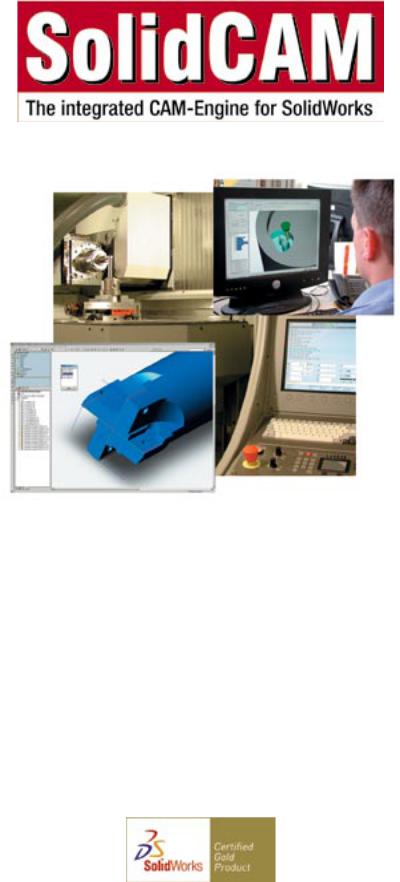
SolidCAM Simultaneous
5-axis Machining
User’s Guide
©1995-2005 SolidCAM LTD.
All Rights Reserved.

SolidCAM2005 Milling Manual |
5-axis Machining |
|
Contents |
|
|
1. Introduction............................................................................................................................... |
5 |
|
2. User Interface........................................................................................................................... |
6 |
|
2.1 |
Adding a 5-axis Operation.................................................................................................... |
6 |
2.2 |
5-axis Operation user interface............................................................................................ |
8 |
2.3 |
Stages of the Simultaneous 5-axis Operations parameters definition ............................... |
10 |
3. CoordSys Page ...................................................................................................................... |
11 |
|
4. Tool Page................................................................................................................................ |
12 |
|
5. Levels Page............................................................................................................................ |
14 |
|
6. Geometry Page ...................................................................................................................... |
17 |
|
6.1 |
Drive surface selection....................................................................................................... |
18 |
6.2 |
Cut Controls:...................................................................................................................... |
20 |
6.2.1 Parallel cuts .................................................................................................................. |
20 |
|
|
Exercise 1:.................................................................................................................... |
23 |
|
Exercise 2:.................................................................................................................... |
25 |
6.2.2 Cuts along curve........................................................................................................... |
26 |
|
|
Exercise 3:.................................................................................................................... |
27 |
|
Exercise 4:.................................................................................................................... |
28 |
6.2.3 Morph between two curves........................................................................................... |
30 |
|
|
Exercise 5:.................................................................................................................... |
32 |
|
Exercise 6:.................................................................................................................... |
34 |
6.2.4 Parallel to curve............................................................................................................ |
36 |
|
|
Exercise 7:.................................................................................................................... |
37 |
|
Exercise 8:.................................................................................................................... |
38 |
6.2.5 Project curves............................................................................................................... |
40 |
|
|
Exercise 9:.................................................................................................................... |
41 |
|
Exercise 10:.................................................................................................................. |
43 |
6.2.6 Morph between two surfaces........................................................................................ |
45 |
|
|
Exercise 11:.................................................................................................................. |
46 |
|
Exercise 12:.................................................................................................................. |
48 |
6.2.7 Parallel to surface......................................................................................................... |
50 |
|
|
Exercise 13:.................................................................................................................. |
52 |
6.3 |
Flip Stepover...................................................................................................................... |
54 |
|
Exercise 14:.................................................................................................................. |
55 |
6.4 |
Cutting Method................................................................................................................... |
56 |
6.5 |
Cut Order ........................................................................................................................... |
58 |
|
Exercise 15:.................................................................................................................. |
60 |
2

5-axis Machining |
SolidCAM2005 Milling Manual |
|
6.6 |
Direction for One Way machining ...................................................................................... |
62 |
|
Exercise 16:.................................................................................................................. |
64 |
6.7 |
Cutting Area....................................................................................................................... |
65 |
|
Exercise 17:.................................................................................................................. |
67 |
6.8 |
Start Point .......................................................................................................................... |
69 |
7. Finish Parameters page: ........................................................................................................ |
71 |
|
7.1 |
Tool Contact point .............................................................................................................. |
72 |
|
Exercise 18:.................................................................................................................. |
75 |
7.2 |
Lead in / Lead out .............................................................................................................. |
79 |
|
Exercise 19:.................................................................................................................. |
82 |
|
Exercise 20:.................................................................................................................. |
86 |
7.3 |
Round surface by tool radius ............................................................................................. |
92 |
7.4 |
Stock to leave..................................................................................................................... |
94 |
7.5 |
Multi Passes....................................................................................................................... |
95 |
7.6 |
Surface Quality................................................................................................................... |
97 |
7.6.1 Chaining Tolerance....................................................................................................... |
97 |
|
7.6.2 Cut tolerance ................................................................................................................ |
98 |
|
7.6.3 Distance........................................................................................................................ |
99 |
|
7.6.4 Stepover ..................................................................................................................... |
100 |
|
8. Gaps Page............................................................................................................................ |
101 |
|
8.1 |
Gap Along Cut.................................................................................................................. |
101 |
8.1.1 Gap Size as % of tool diameter.................................................................................. |
102 |
|
8.1.2 Direct .......................................................................................................................... |
102 |
|
8.1.3 Broken ........................................................................................................................ |
103 |
|
8.1.4 Retract ........................................................................................................................ |
103 |
|
8.1.5 Follow Surface............................................................................................................ |
104 |
|
8.2 |
Gaps between cut (Gap Size as % Of Stepover)............................................................. |
105 |
8.2.1 Gap Size as % of Stepover......................................................................................... |
105 |
|
8.2.2 Direct .......................................................................................................................... |
106 |
|
8.2.3 Broken ........................................................................................................................ |
106 |
|
8.2.4 Retract ........................................................................................................................ |
107 |
|
8.2.5 Follow surface............................................................................................................. |
107 |
|
9. Tool axis control page........................................................................................................... |
108 |
|
9.1 |
Output format................................................................................................................... |
109 |
9.2 |
Maximum angle change................................................................................................... |
110 |
9.3 |
Tilting strategies (Toll axis direction) ................................................................................ |
111 |
9.3.1 Tool axis is not tilted and stays normal to the surface ................................................ |
111 |
|
9.3.2 Tool axis will be tilted relative to cutting direction ...................................................... |
112 |
|
9.3.3 Tool axis will be tilted with the angle .......................................................................... |
114 |
|
3

SolidCAM2005 Milling Manual |
5-axis Machining |
|
9.3.4 Tool axis will be tilted with fixed angle to axis ............................................................ |
114 |
|
9.3.5 Tool axis will tilted around axis ................................................................................... |
115 |
|
9.3.6 Tool axis will be tilted through point ........................................................................... |
116 |
|
9.3.7 Tool axis will be tilted through curve ........................................................................... |
117 |
|
9.3.8 Tool axis will be tilted through lines............................................................................. |
123 |
|
9.3.9 Tilted from point away................................................................................................. |
123 |
|
9.4 Side tilt definition.............................................................................................................. |
124 |
|
9.5 Tool axis direction limit parameters.................................................................................. |
125 |
|
9.5.1 XZ Limit....................................................................................................................... |
126 |
|
9.5.2 YZ Limit....................................................................................................................... |
126 |
|
9.5.3 XY Limit: ..................................................................................................................... |
127 |
|
9.5.4 Conical angles from leading curve.............................................................................. |
127 |
|
10. Gouge Check page ............................................................................................................ |
128 |
|
10.1 |
Clearance....................................................................................................................... |
128 |
10.2 |
Check gouge between positions.................................................................................... |
129 |
10.3 |
Gouge pages.................................................................................................................. |
131 |
10.4 |
Tool................................................................................................................................. |
131 |
10.4.1 Tool Tip and Tool Shaft ............................................................................................. |
131 |
|
10.4.2 Check Arbor and Check Holder................................................................................ |
132 |
|
10.5 |
Strategy.......................................................................................................................... |
132 |
10.5.1 Retracting tool along tool axis................................................................................... |
133 |
|
10.5.2 Moving tool away...................................................................................................... |
134 |
|
10.5.3 Tilting tool away with max angle............................................................................... |
141 |
|
10.5.4 Leaving out gouging points....................................................................................... |
143 |
|
10.5.5 Stop tool path calculation.......................................................................................... |
143 |
|
10.6 |
Drive Surfaces................................................................................................................ |
144 |
10.7 |
Check Surfaces.............................................................................................................. |
144 |
10.8 |
Stock to leave................................................................................................................. |
144 |
11. Stock Page ......................................................................................................................... |
145 |
|
12. Additional parameter Page................................................................................................. |
146 |
|
13. Appendix ............................................................................................................................ |
147 |
|
13.1 |
Single Surface versus Multi Surface Machining in 5 Axis.............................................. |
147 |
13.2 |
At the beginning of all: Single Surface 5 Axis Flowline.................................................. |
147 |
Document number: SC5AUG06001 |
4 |

5-axis Machining |
SolidCAM2005 Milling Manual |
|
|
|
|
1. Introduction
Simultaneous 5-Axis machining is becoming more and more popular due to the need for reduced machining time, better surface finish and improved life span of tools. SolidCAM utilizes all the advantages of Simultaneous 5-Axis machining and together with collision control and machine simulation, provides a solid base for your 5-Axis solution. A number of intelligent and powerful 5- axis machining strategies enable the use of SolidCAM for machining of such complex geometry parts as turbine blades and impellers. SolidCAM provides a realistic simulation of the whole machine tool, showing the motion of all rotational and linear axes.
5
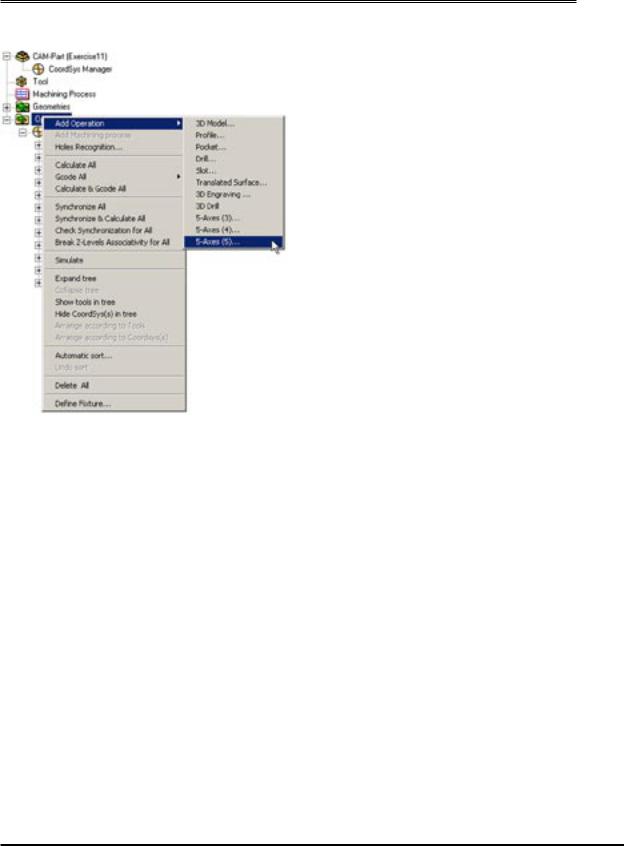
SolidCAM2005 Milling Manual |
5-axis Machining |
|
|
|
|
2. User Interface
2.1 Adding a 5-axis Operation
5-axis (3)
This operation performs 3-axis operations using special tools such as Lollipop and T-cutter, mostly for undercut areas. It is also possible to use the standard tools in this operation in order to create a 3D finish tool path; in this case the operation generates 3 axis G-Code and it is not possible to tilt the tool.
This operation is available for 3 axis, 4 axis and 5 axis CNC-machines.
6

5-axis Machining |
SolidCAM2005 Milling Manual |
|
|
|
|
5-axis (4)
Thisoperation is usedfor 4-axisfinishoperationssuchasturbinebladeprofilesontheoutsidediameter and spiral parts. The tool will be normal to the center line but will not necessarily cross the center line. The only tilt strategies that are available are those that support this type of tilting (4-axis).
This operation generates 4-axis G-code and is available for 4-axis and 5-axis CNC-machines.
This Operation type is unavailable for 3-axis CNC-machine types.
The output from this operation depends on the CNC machine type.
For the 4-axis machine, the output will be performed with the @line_4x and @move_4x commands.
For the 5-axis machine, the output will be performed with the @line_5x and @move_5x commands. With such output, SolidCAM positions the tool to the proper working angle using 5-axis capabilities and then performs the 4-axis machining.
5-axis (5)
This operation is used for 5-axis finish and supports all kinds of 5-axis operations. The user has complete control over all the cutting parameters. The tool can be tilted to any possible direction that the machine supports. All the tilt strategies are available.
The operation generates 5 axis G-code. The @line_5x and @move_5x commands will be used in the output.
This type of operation is available only for postprocessors that support 5-axis machining.
7
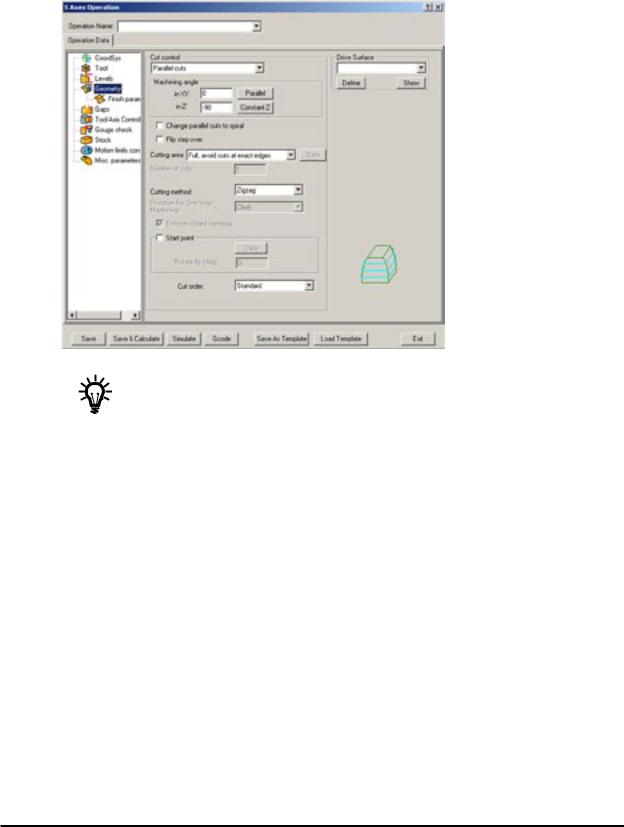
SolidCAM2005 Milling Manual |
5-axis Machining |
|
|
|
|
2.2 5-axis Operation user interface
The following 5-axis Operation dialog is displayed on the screen:
The parameters of the 5-axis Milling Operation are divided into a number of sub-groups. The sub-groups are displayed in a tree format on the left side of the 5-axis Operation dialog box. When you click on an item in the tree, the parameters of the selected sub-group appear on the right side of the Operation dialog box.
• CoordSys Page
Define the CoordSys Position for the 5-axis machining.
• Tool Data Page
Choose a tool for the operation and define tool-related parameters such as feed and spin.
• Levels Page
Define Milling levels such as Clearance plane and Safety distance.
• Geometry
SolidCAM enables you to choose a drive surface for the machining. Define the machining parameters such as the Cut control, Cuting area, Cutting method etc.
8

5-axis Machining |
SolidCAM2005 Milling Manual |
|
|
|
|
•Finish Parameters
This page enables you to define the machining parameters such as Cut tolerances, Stock to leave, Run tool etc.
• Gaps Page
Surfaces defining the work piece can have gaps and holes. In such cases you can choose between several options. For example you can choose to have small gaps ignored and milled without the tool retracting and big gaps detected with the tool retracting back to the rapid plane and skipping the gap. Such options are set within this dialog. Entry and Exit moves are also defined here.
• Tool axis control
Define the tool orientation relative to the surface normal.
• Gouge check
This page contains all the options to avoid the tool gouging selected drive surfaces and check surfaces.
• Motion Limit control
This page is related to CNC machine definitions. The defaults are determined by the MAC-file (machine definition parameters). Generally, these parameters are defined in the first definition of the postprocessor for this machine and usually it is not necessary to change these values. The Motion Limit control page enables you to change the parameters locally for the current operation.
• Stock Page
Stock definition can be provided in this page. All tool moves in the air that do not remove material will be trimmed using this given stock definition.
• Miscellaneous parameters
This page contains special functions for custom applications.
9
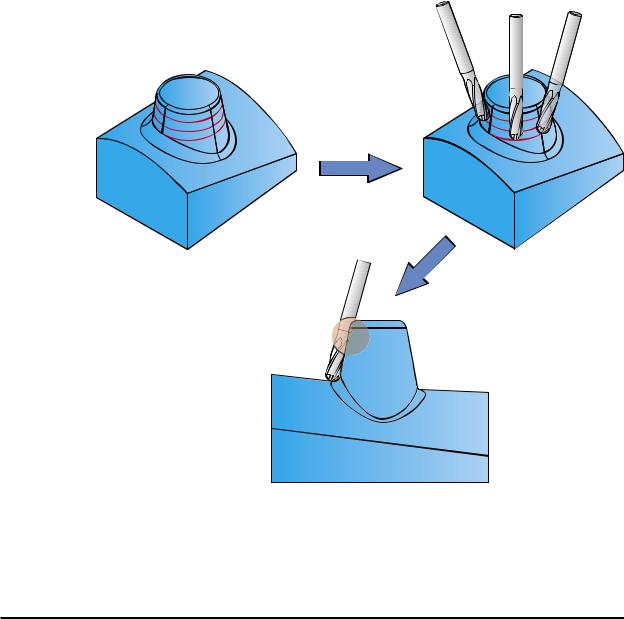
SolidCAM2005 Milling Manual |
5-axis Machining |
|
|
|
|
2.3 Stages of the Simultaneous 5-axis Operations parameters definition
The process of the Operation parameters definition for the tool path creation is divided into 3 stages:
1. Geometry, Finish Parameters and Gaps – the type of finish tool paths generated along the selected faces is defined. Tool tilting and gouging are not taken into account at this stage.
2. Tool axis control - controls the angle of the tool from the normal vector in every point along the tool path.
3. Gouge check –the gouge strategies that SolidCAM has to take into account to avoid tool and holder crashes are defined.
Tool path generation |
Tool axis control |
Gouge check
10
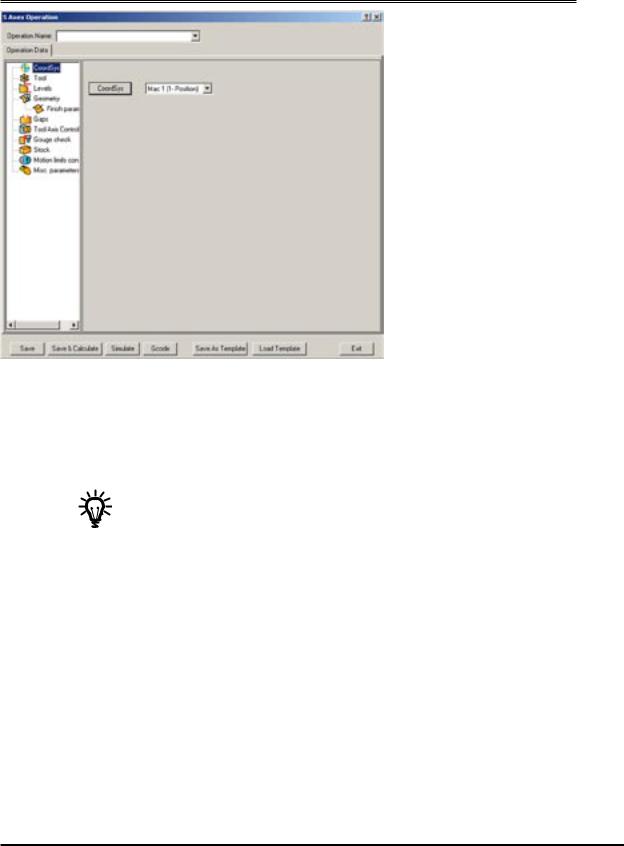
5-axis Machining |
SolidCAM2005 Milling Manual |
|
|
|
|
3. CoordSys Page
Choose the appropriate CoordSys position for the operation. The CoordSys Position can be chosen either direcly on the model or from the list.
After the CoordSys selection, the model will be rotated to the selected CoordSys orientation.
The CoordSys selection operation must be the first step in the Operation definition process.
In the 5 axis (3) Operation, SolidCAM enables you to choose both the Machine Coordinate systems and CoordSys Positions for the operation. In 5 axis (4) and 5 axis (5) operations, SolidCAM enables you to choose only the Machine Coordinate systems. The Machine CoordSys definition contains data of the Machine CoordSys location relative to the center of the rotation of the machine. Therefore, SolidCAM enables you to generate the G-Code according to the center of the rotation of the machine.
11
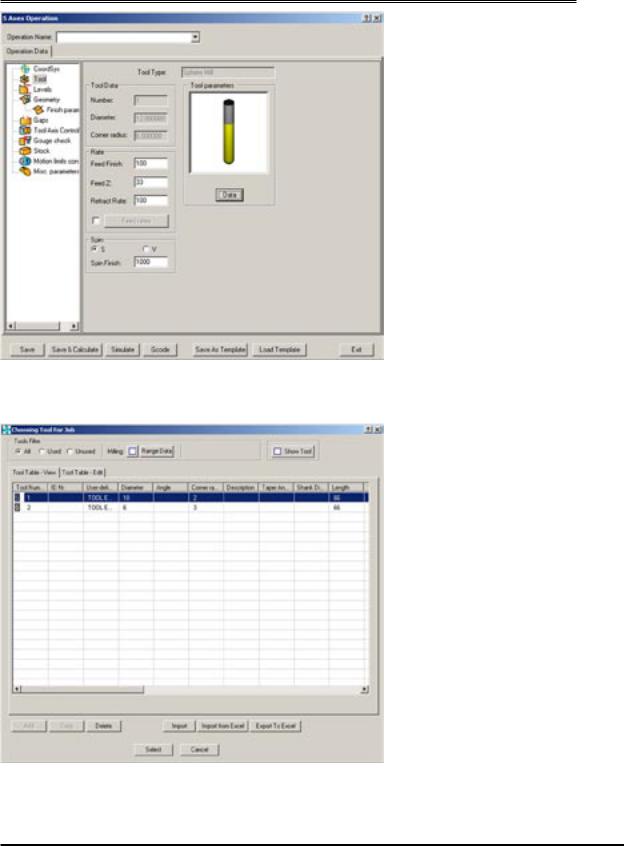
SolidCAM2005 Milling Manual |
5-axis Machining |
|
|
|
|
4. Tool Page
The Data button enables you to choose a tool from the Part Tool Table.
12
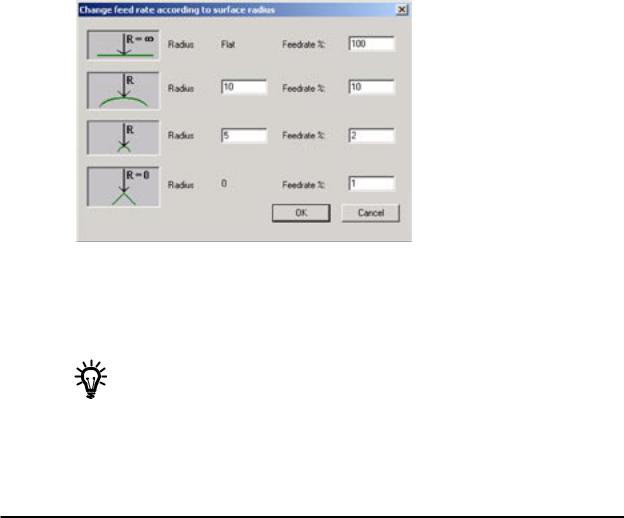
5-axis Machining |
SolidCAM2005 Milling Manual |
|
|
|
|
Feed Finish
This field gets the default from the Feed Finish parameter in the Tool Data dialog. If the user changes this value it will not change the related field in the Tool Data dialog.
Feed Z
The feed that SolidCAM will use to move from the safety position to the depth point.
Retract Rate
The feed that SolidCAM will use to move the tool from the material to the retract level.
Spin Finish
The spindle speed for the cutting operation.
Feed Rates
If this switch is set, then the feed rate optimizer is utilized. The feed rate optimizer uses the machining feed rate supplied by the user and modifies this feed rate based on the surface curvature. The surface curvature is calculated at each tool path position where the surface contact point of the tool is known.
This function works only on single surfaces and can’t be used to connect 2 surfaces
13
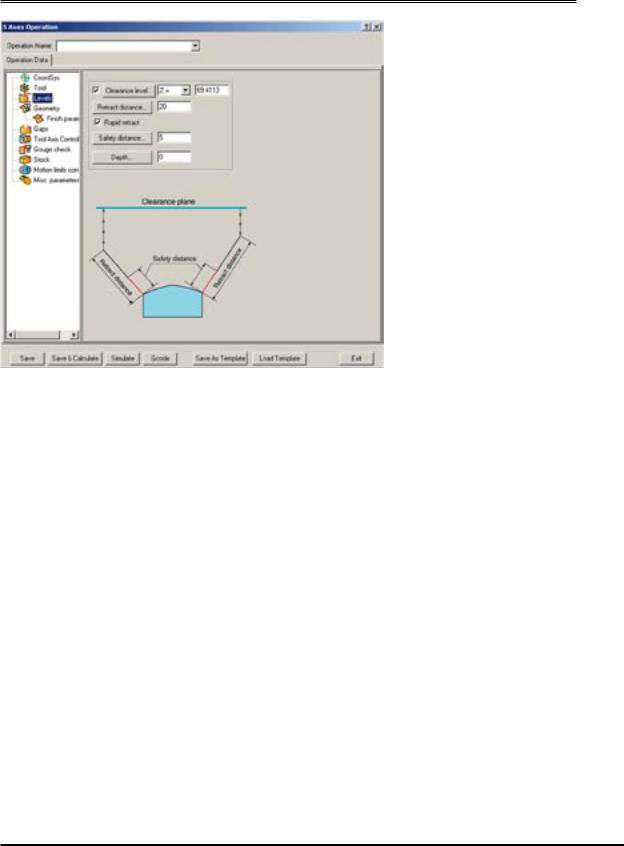
SolidCAM2005 Milling Manual |
5-axis Machining |
|
|
|
|
5. Levels Page
Clearance Plane
The clearance plane is a Z coordinate value and presents an absolute plane at this height which is parallel to the XY plane. The tool moves from and to this clearance plane to make major repositionings. In some cases like turbine blade machining around the X axis, it might be better to have the clearance plane defined in the X axis. Setting the clearance plane height in the X axis will make the YZ plane the parallel plane and the given X value will be the clearance value over this plane.
14
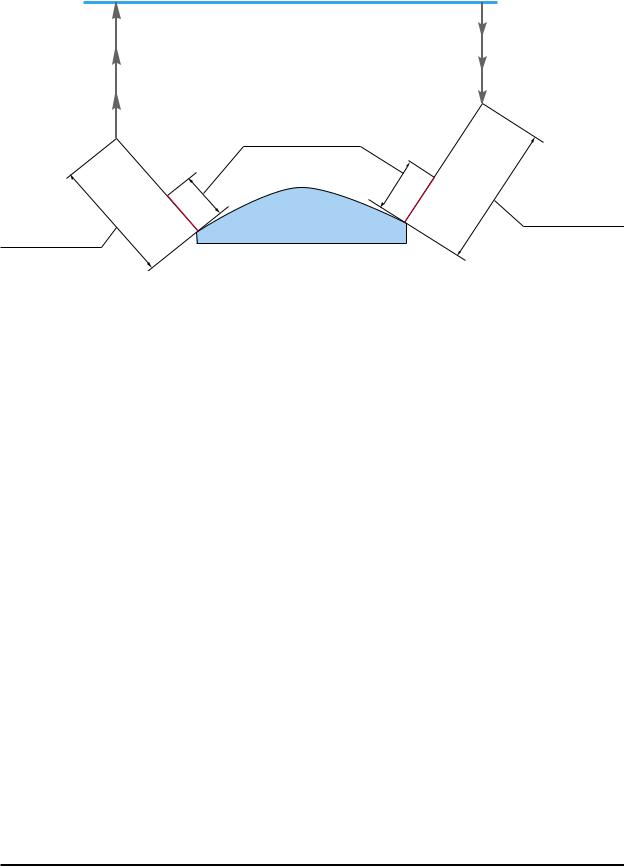
5-axis Machining |
SolidCAM2005 Milling Manual |
|
|
|
|
Clearance plane
Safety distance
Retract distance
Retract distance
Retract Distance and Safety Distance
The tool changes its orientation at the clearance plane (machine tables or spindles are turned) and then it moves down to the part to the retract distance. The tool then moves in a rapid motion with some orientation to the safety distance. The tool then approaches the surface with the cutting feed rate.
Rapid Retract
This option enables you to perform the retract movement with the rapid feed.
When this option is not active, the tool will be moved to the safety distance with the defined Retract Feed (see topic 4.).
Rapid feed
Retract Rate
 Retract distance
Retract distance
Safety distance
15

SolidCAM2005 Milling Manual |
5-axis Machining |
|
|
|
|
When the Rapid Retract option is active, the retract movement will be performed with the
Rapid Feed.
Rapid feed
 Retract distance
Retract distance
Safety distance
Depth
The Depth defines a further offset of the tool in the axial direction (especially for swarf operations).
This command shifts each point of the tool path in the vector direction of the tool. The start position of the cutting will also be shifted. The gouge control will take out all the gouges that result from this shift.
16
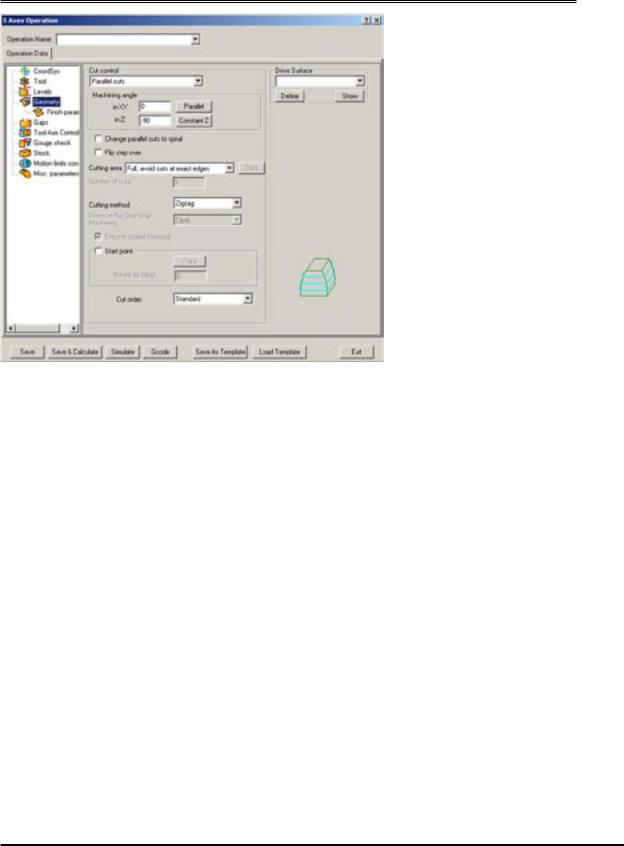
5-axis Machining |
SolidCAM2005 Milling Manual |
|
|
|
|
6. Geometry Page
This page enables you to select the faces to be machined and the machining strategy. The different strategies available are:
•Parallel cuts
•Cut along curve
•Morph between 2 curves
•Parallel to curve
•Project curve
•Morph between 2 surfaces
•Parallel to surface
For all the above strategies, select the drive surface and the related geometries. In the Morph between 2 curves and Parallel to curve strategies, the curves have to be part of the surface external boundaries. Select the faces first, and than select the edges. Do not use sketches to define these types of geometries.
17

SolidCAM2005 Milling Manual |
5-axis Machining |
|
|
|
|
6.1 Drive surface selection
Click on the Define button. The Choose faces dialog will be displayed.
This dialog enables you to select one or several faces of the SolidWorks model. The selected Face tags will be displayed in the dialog.
If you chose wrong entities, use the Unselect option to undo your selection. You can also right click on the entity name (the object will be highlighted) and choose the Unselect option from the menu.
18

5-axis Machining |
SolidCAM2005 Milling Manual |
|
|
|
|
SolidCAM enables you to machine surfaces from the positive direction of the surface normals. Sometimes surfaces are not oriented correctly and you have to reverse their normals. The Reverse/Reverse All command enables you to reverse the direction of the surface normals.
SolidCAM does not enable you to see the surface direction. You have to select the faces for the 5 axis operation and calculate the operation. If the tool is machining one of the faces from the wrong direction, return to the Geometry definition and use the Reverse command.
19
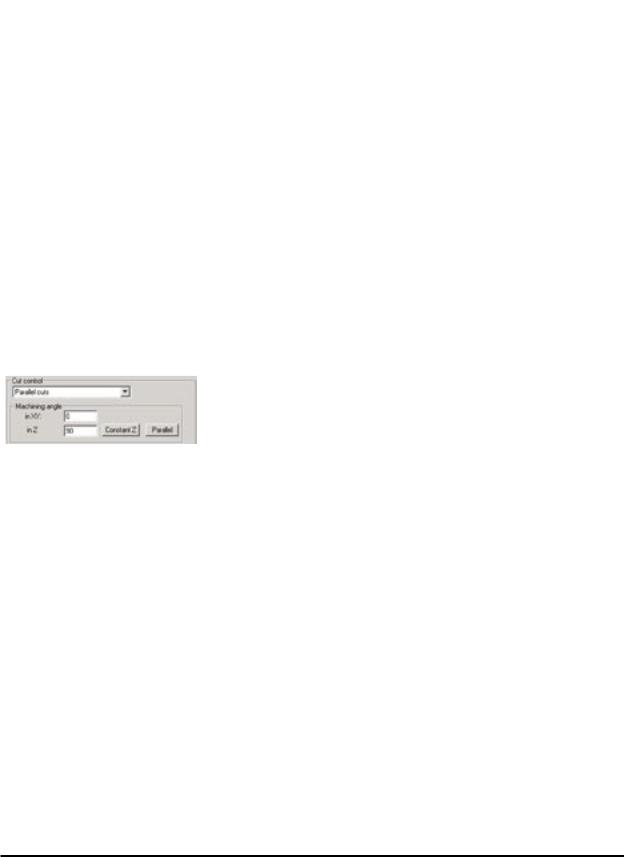
SolidCAM2005 Milling Manual |
5-axis Machining |
|
|
|
|
6.2 Cut Controls:
The Exercises of the Cut control option are located in the Exercises\Cut_Control folder.
6.2.1 Parallel cuts
The Parallel cuts option will create tool paths that are parallel to each other. The direction of the cuts is defined by two angles. The angles in X, Y and Z determine the direction of the parallel cuts of the tool path. Imagine slicing an apple: You can slice it with a knife parallel from top to bottom or from the left side to the right side. The pictures in the dialog show how the desired cutting direction is set using the angles.
With constant X
 Y
Y
X
Changing the Machining angle in the Z parameter to 90 degrees creates tool paths parallel to the Y axis. The X-distance is constant.
20
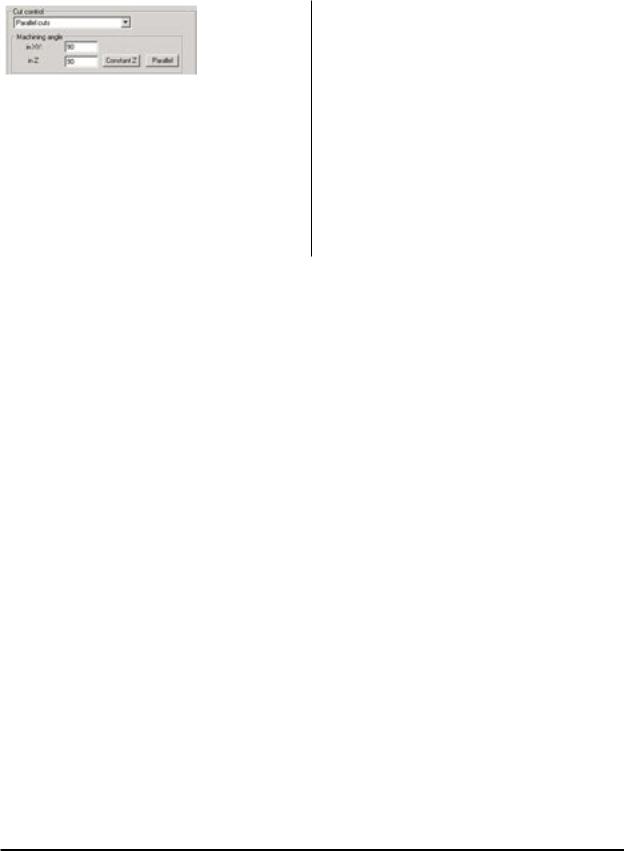
5-axis Machining |
SolidCAM2005 Milling Manual |
|
|
|
|
With constant Y
 Y
Y
X
Changing the Machining angle in Z and the Machining angle in X, Y to 90 degrees creates tool paths parallel to the X axis. The Y-distance is constant.
With constant Z
 Z
Z
X
Changing the Machining angle in Z and the Machining angle in X, Y to 0 degrees creates circular tool paths. The Z-distance is constant.
21

SolidCAM2005 Milling Manual |
5-axis Machining |
|
|
|
|
Fast orientation buttons
Th following buttons enable you to expedite the definition of the orientation of the parallel cuts. The button.
The Parallel button.
In this setup you can enter any angle to get the required tool path.
22
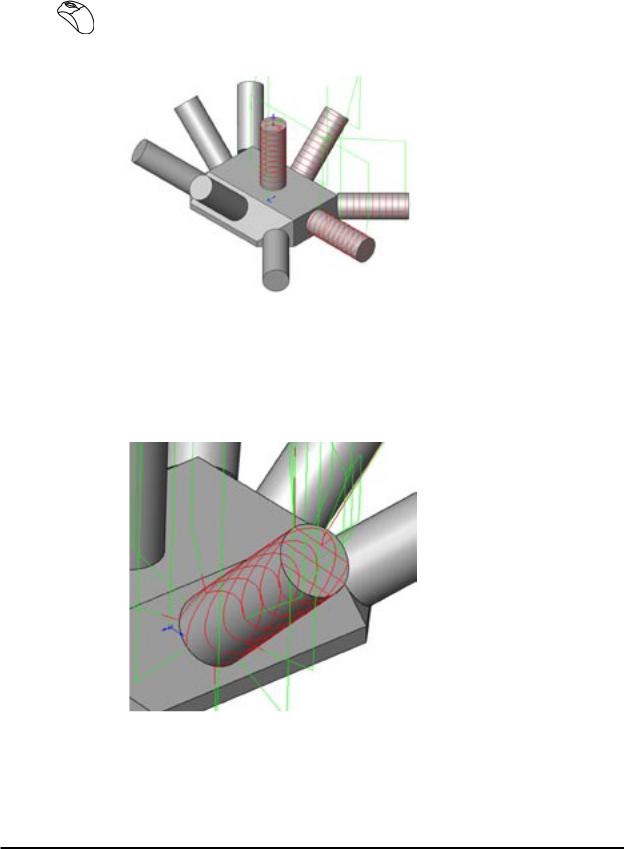
5-axis Machining |
SolidCAM2005 Milling Manual |
|
|
|
|
Exercise 1:
1. Load the CAM-Part: Exercises\Cut_control\parallel_cuts.prt
2.Simulate the operations and check the parameters used to control the Machining angles for the Parallel Cuts strategy.
3.Add operations for the machining of other cylinders. Use the Parallel Cuts strategy and define the necessary parameters in order to cut the cylinder normal to the direction of the center line.
4.In order to cut the cylinder and the top face you have to use a different angle (inclination). Create some operations to practice this task.
23
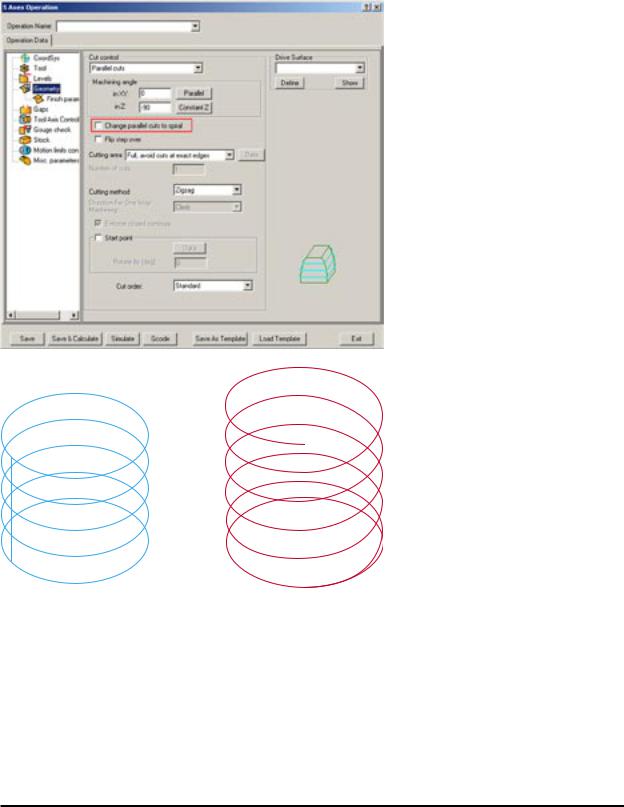
SolidCAM2005 Milling Manual |
5-axis Machining |
|
|
|
|
Change Parallel cuts to spiral
This option enables you to substitute the parallel cuts with the spiral cuts with the pitch equal to the defined Step over.
The option is not chosen |
The option is chosen |
24
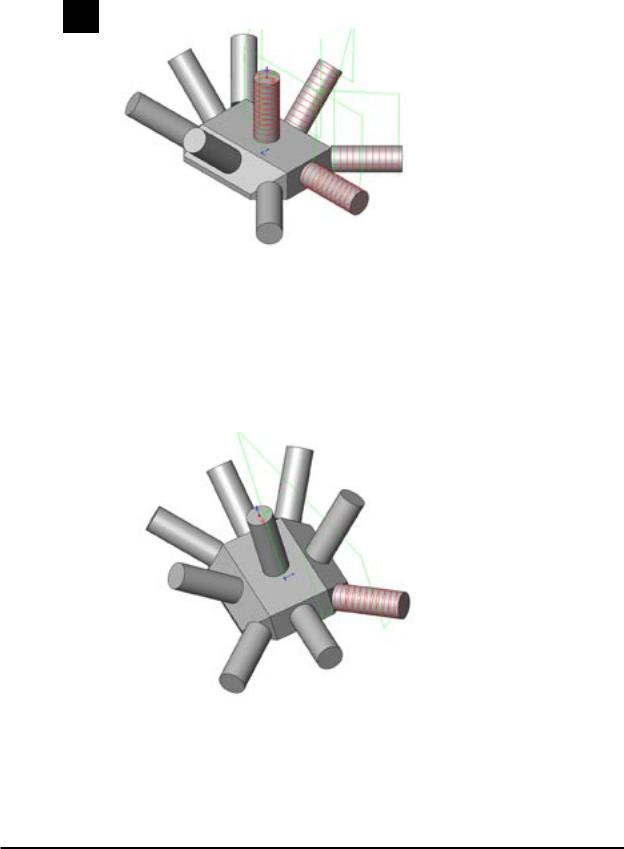
5-axis Machining |
SolidCAM2005 Milling Manual |
|
|
|
|
Exercise 2:
1. Load the CAM-Part: Exercises\Cut_control\parallel_cuts.prt
2.Simulate the operations and check the parameters used to control the Machining angles for the Parallel Cuts strategy.
3.Edit the operation rotate around z 45 deg.
4.In the Geometry page, choose the Change parallel cuts to spiral option.
5.Calculate and simulate the operation. Note that the parallel cuts of the operation were changed to spiral movements.
25
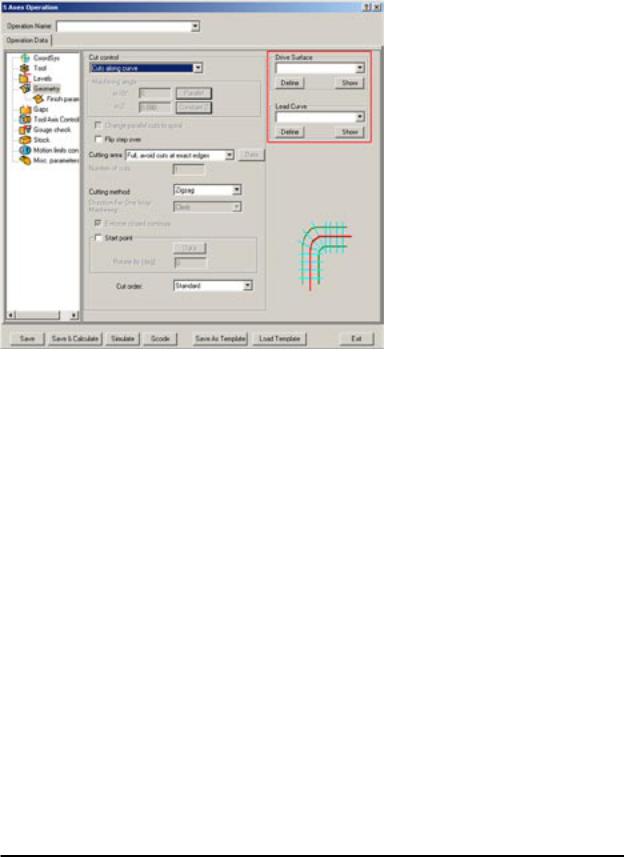
SolidCAM2005 Milling Manual |
5-axis Machining |
|
|
|
|
6.2.2 Cuts along curve
The Cuts along curve option enables the user to select a leading curve. The generated tool path is orthogonal to this leading curve, so the cuts do not have to be parallel to each other. If a wrong leading curve is selected, the cuts can cross over each other and the result will be unacceptable.
The curve geometry does not have to be located on the surface or on the edges of the surface. The selected chain could be a planar or a 3D sketch. In each point of the leading curve, SolidCAM creates a plane nornal to the curve. The tool path will be created at the intersection of this plane with the drive surface.
This kind of tool path is popular for milling engines ports or internal curved surfaces.
Curve
Tool path
 90°
90°
90° 
26

5-axis Machining |
SolidCAM2005 Milling Manual |
|
|
|
|
Exercise 3:
1. Load the SolidWorks document: Exercises\Cut_control\cone.sldprt
2.Define a new CAM-Part. Use the Fanuc_4x_x postprocessor.
3.Define the Machine CoordSys with the X-axis directed along the cone centerline
and the Z-axis directed upwards. For the CoordSys definition, use the home_ definition sketch.
4.Start a new 5-axis Operation and choose the Cuts Along Curve strategy.
5.Define the conical face as the drive surface. Choose the circle segment contained in the Lead_ curve sketch as a lead curve.
6.Calculate and Simulate the
Operation.
27
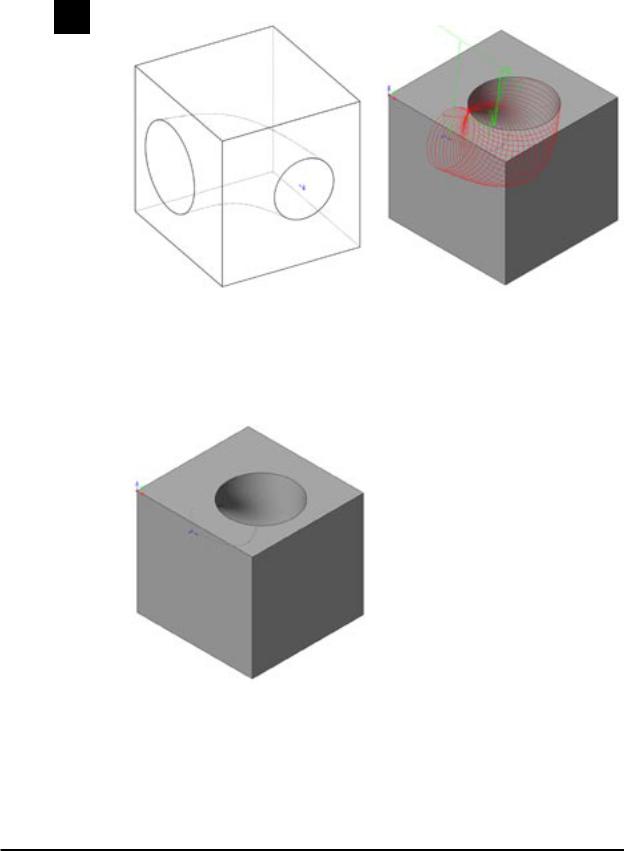
SolidCAM2005 Milling Manual |
5-axis Machining |
|
|
|
|
Exercise 4:
1. Load the SolidWorks document: Exercises\Cut_control\cone.sldprt
2.Create a new CAM-Part. Use the Fanuc_5x CNC controller.
3.Define the CoordSys on the top face of the model.
4.Start a new 5-axis Operation and choose the Cuts Along Curve strategy.
5.Define the internal face of the manifold as the Drive Surface and the sketch
segment containd in the Center_line sketch as a Lead curve.
28

5-axis Machining |
SolidCAM2005 Milling Manual |
|
|
|
|
6. Calculate and Simulate the Operation.
The simulation can be performed using either 3D or HostCAD simulation modes.
29
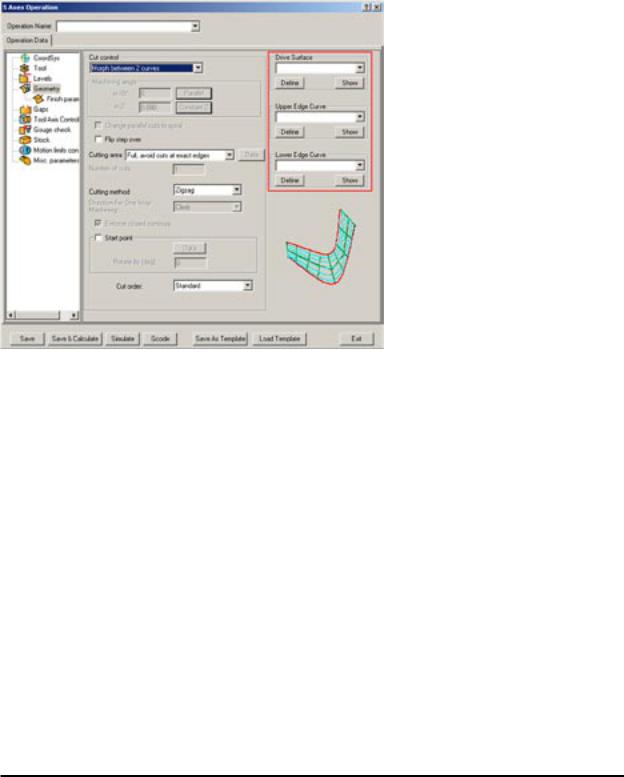
SolidCAM2005 Milling Manual |
5-axis Machining |
|
|
|
|
6.2.3 Morph between two curves
The Morph between two curves option will create swarf cuts morphing between two leading curves. This option is very suitable for machining steep areas for mould making. The more accurate the guiding curves are to the real surface edges, the better this function works.
To select the first (upper) and second (lower) curve, click on the Upper and Lower button.
First curve
Tool path
Second curve
30
